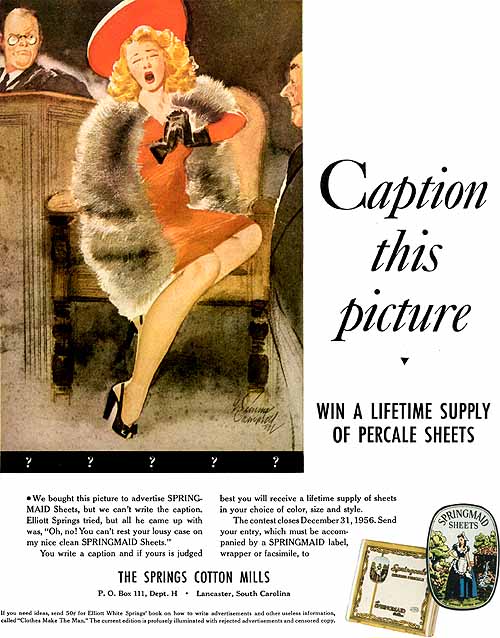Elliott White Springs, Man After My Own Heart
This article, The Death of the Double Entendre, sent me off to try and learn more about textiles manufacturer Elliott White Springs. Article excerpt:
As Charles Goodrum and Helen Dalrymple explain in their book Advertising in America, Springs relied on four principles. First, the reader was considered an intelligent peer, not an easy-to-titillate sucker. Second, a product benefit had to be offered once the reader's attention was gained through pulchritudinous means. Next, racy images should combine humour and respect — Springs' ads objectified men and women, although both retained their dignity. The final principle was the most important: The Tease was the most effective method of leveraging sex in an ad. An inch of stocking top worked far better than a topless woman.
Here are some comments about his ad campaigns, here's what Snopes has to say, here's something about controversies associated with his book about being a WWI pilot, and here's an American Heritage article on his life and work. AH excerpt:
Once the manufacturing facilities were in place, Elliott set out to make the Springmaid trademark a household name. He did it by using his gift for the English language, his irrepressible sense of humor, and his love for—guess what—wine, women, and song. He created a now-legendary advertising campaign that featured drawings of leggy, bosomy women supposedly dressed, to the extent that they were dressed at all, in Springmaid fabrics. His copy was full of double entendres and risqué innuendos.
“Protect your assets,” warned one ad that featured three showgirls backstage dressed in the miniest of mini-skirts. “Beware the goose,” suggested another, showing a farm girl startled by an aggressive gander. “We put the broad in the broadcloth,” offered a third. The most famous pictured a hammock made from a Springmaid sheet. In it, sinking into a blissful repose, is a young Indian brave. Stepping out of the hammock is a clearly satisfied Indian maiden. The headline: “A buck well spent on a Springmaid sheet.”
The Pooh-Bahs of the advertising industry were scandalized. Some of the prissier magazines, notably The New Yorker and Life, refused to run the ads. But the campaign did exactly what Elliott had hoped for: it made Springmaid a household name. He claimed that when his campaign began, Springmaid sheets were sold in only six retail outlets. A few months later they were sold in ten thousand and were soon the largest-selling brand in the country. (Note -- they're still in business.)
I'm also going to have to check out some of the artists who created these ads, too, like E. Simms Campbell. Even James Montgomery Flagg, the guy who made Uncle Sam's "I Want You" poster, drew some Springmaid material.
I can't provide the lifetime supply of sheets, but we could have the caption contest anyway.











3 Comments:
Caption:
" And the worst part, you honor, is that I caught them on my new Springmaid sheets!"
What's the prize anyway?
he he
In order to create a Holloween ghost outfit for his son, he sliced a pair of eye slits in one of my new Springmaid sheet!
I was so embarrassed, your Honor, instead of table cloths our butler set up a dinner party for twenty using my Springmaid sheets!
Post a Comment
<< Home